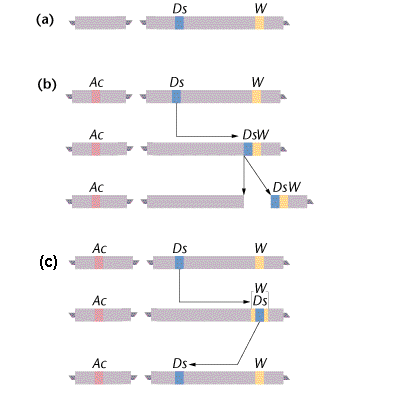
The Ac - Ds system in maize (Zea): genetics of "jumping genes"

In the presence of an Activator (Ac) element, a Dissociator (Ds) element can cause chromosome breaks. The genetic marker for such breaks in this example is expression at the W locus: the dominant W allele produces a mutant White phenotype, and the recessive W+ allele produces a wild-type dark phenotype. In the above example, the plant is a W / W+ heterozygote: the other chromosome set is not shown.
(a) In the absence of Ac element, Ds is not transposable and chromosome breaks do not occur. The W allele is expressed as expected.
(b) In the presence of an Ac element, the Ds element can be transposed ("jump") elsewhere in the chromosome. This transposition can cause a chromosome break at the point of insertion, so that the Ds element and any downstream loci are lost. In a W / W+ heterozygote, loss of the W allele would allow expression of the alternative W+ allele, producing an unexpected dark phenotype
(c) Ds transposition can also cause the element to jump into the middle of the W allele, disrupting its normal function and again allowing expression of the alternative W+ allele. Still under the influence of Ac, Ds may subsequently jump back out of W, restoring function of W. The plant will then be a mosaic of cell patches, expressing either W or W+.